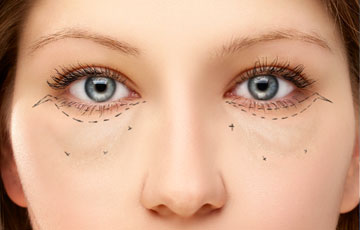
What is a lower blepharoplasty?
Lower eyelid blepharoplasty is a surgery that addresses the excess skin and appearance of “bags” underneath the eyes by reducing or repositioning the fat. Lower eyelid blepharoplasty is generally more complex than upper eyelid blepharoplasty, but has been done for many years and recent techniques have improved the risks considerably. Having a knowledgeable and experienced surgeon can help with reducing complications and optimizing outcomes.
There are two major approaches for addressing the lower eyelid tissue
Transconjunctival blepharoplasty:
The transconjunctival approach allows the surgeon to address the fat – reducing or repositioning it – with no visible incisions or stitches. This is done commonly with CO2 laser or Ellman radiosurgical device. When appropriate, this approach has many advantages – it leaves no scar and minimizes risk of eyelid malposition or changing the shape of the eyelid. However, oftentimes there is also a need to address skin laxity, and so this approach can be combined with a small removal of skin, or “skin pinch” technique. Fine wrinkles and skin texture can also be improved by combining transconjunctival blepharoplasty with CO2 laser resurfacing or TCA peels.
External-approach blepharoplasty:
External-approach blepharoplasty is necessary when skin, fat, or the whole eyelid, needs to be surgically tightened and repaired.
This technique provides direct access to underlying tissues, allowing precise reshaping or tightening to improve vision or aesthetics. It’s commonly performed to correct droopy eyelids (ptosis) or under-eye bags and leaves a scar that typically blends well with the natural contours of the eye. It is very important to recognize that there must be adequate skin in the lower lid to allow closure and normal upward movements of the eyelid, and to keep good contact between eyelid and the eyeball.
What to expect during your consultation:
Your surgeon will evaluate the eyelid anatomy and eye health to help you choose the most appropriate process to address your goals. As such, it is important for your surgeon to understand your goals and lifestyle, while conveying expectations for surgery and also its limitations. The lower lid is not a simple fixed tissue, but rather it moves up and down with blinking and different positions of gaze, and it needs to have constant appropriate contact with the eyelid. There are always risks with surgery and your surgeon will discuss these with you. All our doctors are fellowship-trained oculoplastic surgeons who can evaluate these features of the lower eyelid, and understand the underlying eye and its physiology – keys to successful lower eyelid surgery.
What is the procedure like?
Cosmetic surgery of the lower eyelids is almost always done under local anesthetic with intravenous sedation. An anesthesiologist is in attendance and administers intravenous medications to allow your comfort and relaxation. Shields are commonly placed over the eyes for protection, and these also help improve patient comfort. After surgery, you will be reclined in the recovery room while you start icing your eyelids. The recovery nurse reviews post-operative instructions and ensures you are comfortable before departing home.
What to expect after lower eyelid blepharoplasty?
Bruising and swelling begin on the day of the procedure, commonly worsening for the first 3 – 4 days and improving over the next 1 – 2 weeks. Redness can develop on the eyeball (subconjunctival hemorrhage), which is a form of bruising– though alarming to see, it is actually quite benign. Swelling on the surface of the eye (chemosis) is also not uncommon, and can require lubrication with artificial tears. Blurred vision, irritation in the eye, and dryness are common in the first few weeks of healing from a lower eyelid blepharoplasty. Recovery time is usually two to three weeks for bruising, return to strenuous activity, contact lens wear, and makeup. Additional time is needed for scars to settle and for swelling to dissipate.